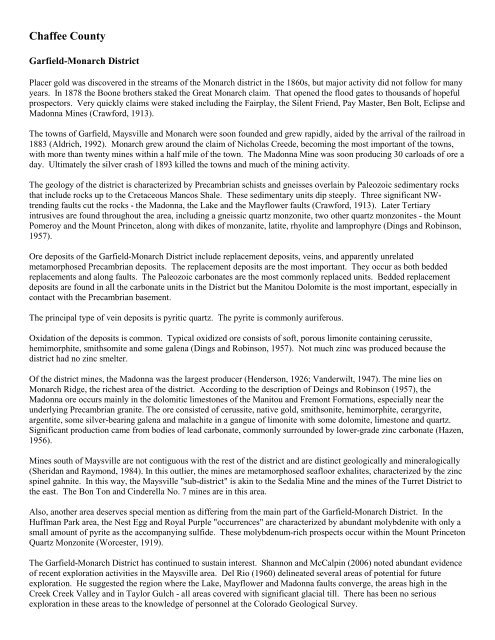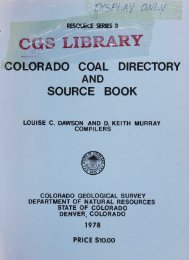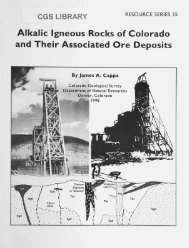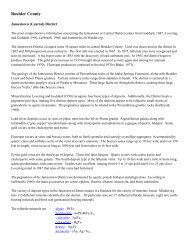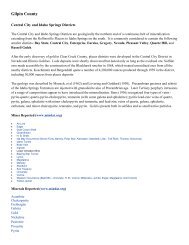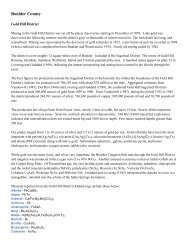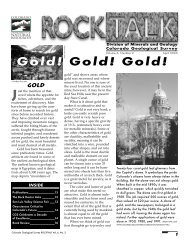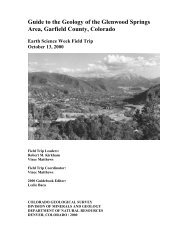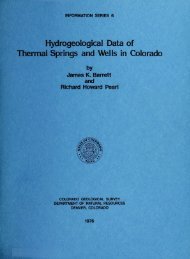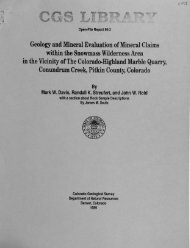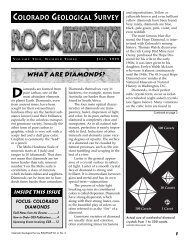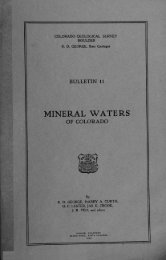Garfield-Monarch Historic Mining District - Colorado Geological Survey
Garfield-Monarch Historic Mining District - Colorado Geological Survey
Garfield-Monarch Historic Mining District - Colorado Geological Survey
Create successful ePaper yourself
Turn your PDF publications into a flip-book with our unique Google optimized e-Paper software.
Chaffee County<br />
<strong>Garfield</strong>-<strong>Monarch</strong> <strong>District</strong><br />
Placer gold was discovered in the streams of the <strong>Monarch</strong> district in the 1860s, but major activity did not follow for many<br />
years. In 1878 the Boone brothers staked the Great <strong>Monarch</strong> claim. That opened the flood gates to thousands of hopeful<br />
prospectors. Very quickly claims were staked including the Fairplay, the Silent Friend, Pay Master, Ben Bolt, Eclipse and<br />
Madonna Mines (Crawford, 1913).<br />
The towns of <strong>Garfield</strong>, Maysville and <strong>Monarch</strong> were soon founded and grew rapidly, aided by the arrival of the railroad in<br />
1883 (Aldrich, 1992). <strong>Monarch</strong> grew around the claim of Nicholas Creede, becoming the most important of the towns,<br />
with more than twenty mines within a half mile of the town. The Madonna Mine was soon producing 30 carloads of ore a<br />
day. Ultimately the silver crash of 1893 killed the towns and much of the mining activity.<br />
The geology of the district is characterized by Precambrian schists and gneisses overlain by Paleozoic sedimentary rocks<br />
that include rocks up to the Cretaceous Mancos Shale. These sedimentary units dip steeply. Three significant NWtrending<br />
faults cut the rocks - the Madonna, the Lake and the Mayflower faults (Crawford, 1913). Later Tertiary<br />
intrusives are found throughout the area, including a gneissic quartz monzonite, two other quartz monzonites - the Mount<br />
Pomeroy and the Mount Princeton, along with dikes of monzanite, latite, rhyolite and lamprophyre (Dings and Robinson,<br />
1957).<br />
Ore deposits of the <strong>Garfield</strong>-<strong>Monarch</strong> <strong>District</strong> include replacement deposits, veins, and apparently unrelated<br />
metamorphosed Precambrian deposits. The replacement deposits are the most important. They occur as both bedded<br />
replacements and along faults. The Paleozoic carbonates are the most commonly replaced units. Bedded replacement<br />
deposits are found in all the carbonate units in the <strong>District</strong> but the Manitou Dolomite is the most important, especially in<br />
contact with the Precambrian basement.<br />
The principal type of vein deposits is pyritic quartz. The pyrite is commonly auriferous.<br />
Oxidation of the deposits is common. Typical oxidized ore consists of soft, porous limonite containing cerussite,<br />
hemimorphite, smithsomite and some galena (Dings and Robinson, 1957). Not much zinc was produced because the<br />
district had no zinc smelter.<br />
Of the district mines, the Madonna was the largest producer (Henderson, 1926; Vanderwilt, 1947). The mine lies on<br />
<strong>Monarch</strong> Ridge, the richest area of the district. According to the description of Deings and Robinson (1957), the<br />
Madonna ore occurs mainly in the dolomitic limestones of the Manitou and Fremont Formations, especially near the<br />
underlying Precambrian granite. The ore consisted of cerussite, native gold, smithsonite, hemimorphite, cerargyrite,<br />
argentite, some silver-bearing galena and malachite in a gangue of limonite with some dolomite, limestone and quartz.<br />
Significant production came from bodies of lead carbonate, commonly surrounded by lower-grade zinc carbonate (Hazen,<br />
1956).<br />
Mines south of Maysville are not contiguous with the rest of the district and are distinct geologically and mineralogically<br />
(Sheridan and Raymond, 1984). In this outlier, the mines are metamorphosed seafloor exhalites, characterized by the zinc<br />
spinel gahnite. In this way, the Maysville "sub-district" is akin to the Sedalia Mine and the mines of the Turret <strong>District</strong> to<br />
the east. The Bon Ton and Cinderella No. 7 mines are in this area.<br />
Also, another area deserves special mention as differing from the main part of the <strong>Garfield</strong>-<strong>Monarch</strong> <strong>District</strong>. In the<br />
Huffman Park area, the Nest Egg and Royal Purple "occurrences" are characterized by abundant molybdenite with only a<br />
small amount of pyrite as the accompanying sulfide. These molybdenum-rich prospects occur within the Mount Princeton<br />
Quartz Monzonite (Worcester, 1919).<br />
The <strong>Garfield</strong>-<strong>Monarch</strong> <strong>District</strong> has continued to sustain interest. Shannon and McCalpin (2006) noted abundant evidence<br />
of recent exploration activities in the Maysville area. Del Rio (1960) delineated several areas of potential for future<br />
exploration. He suggested the region where the Lake, Mayflower and Madonna faults converge, the areas high in the<br />
Creek Creek Valley and in Taylor Gulch - all areas covered with significant glacial till. There has been no serious<br />
exploration in these areas to the knowledge of personnel at the <strong>Colorado</strong> <strong>Geological</strong> <strong>Survey</strong>.
Mineral list contains entries from the region specified including sub-localities (Mindat.org)<br />
Acanthite<br />
Actinolite<br />
Almandine<br />
Andradite<br />
Anglesite<br />
Ankerite<br />
Anthophyllite<br />
'Asbestos'<br />
Azurite<br />
Beryl<br />
var: Aquamarine<br />
Biotite<br />
Bornite<br />
Brochantite<br />
Calcite<br />
Cerussite<br />
Chalcocite<br />
Chalcopyrite<br />
Chlorargyrite<br />
'Chlorite Group'<br />
<strong>Garfield</strong>-<strong>Monarch</strong> mines<br />
Chrysocolla<br />
Copper<br />
'Copper Stain'<br />
Cordierite<br />
Cuprite<br />
Diopside<br />
Dolomite<br />
var: Ferroan Dolomite<br />
Epidote<br />
'Feldspar Group'<br />
Fluorite<br />
Gahnite<br />
Galena<br />
var: Argentiferous Galena<br />
'Garnet'<br />
Gedrite<br />
Goethite<br />
Gold<br />
Graphite<br />
Grossular<br />
Gypsum<br />
Hematite<br />
var: Specularite<br />
Hemimorphite<br />
'Hornblende'<br />
Hübnerite<br />
Limonite<br />
Lizardite<br />
Magnetite<br />
Malachite<br />
Mimetite<br />
Molybdenite<br />
Muscovite<br />
'Olivine'<br />
Phenakite<br />
Phlogopite<br />
Plumbojarosite<br />
'Psilomelane'<br />
Pyrite<br />
Pyrolusite<br />
Pyrrhotite<br />
Quartz<br />
var: Chert<br />
Scheelite<br />
'Serpentine Group'<br />
Siderite<br />
Sillimanite<br />
Silver<br />
Smithsonite<br />
Sphalerite<br />
Stephanite<br />
Sylvanite ?<br />
Tenorite<br />
Tremolite<br />
'Wad'<br />
Wollastonite<br />
Wulfenite<br />
Asterisk * indicates mines with extended written descriptions in Dings and Robinson (1957);<br />
mines marked with @ are located in the Maysville area sub-district, described in Sheridan and Raymond (1984);<br />
# notes the mine is described by Worcester (1919);<br />
Mines marked with ^ are specifically mentioned in Heyl's publication on oxidized zinc deposits of <strong>Colorado</strong> (1964);<br />
+ denotes mines detailed in Crawford (1913);<br />
Unmarked mines are from Mindat.org alone.<br />
<strong>Colorado</strong><br />
Chaffee Co.<br />
<strong>Monarch</strong> <strong>District</strong><br />
+^*Alaska Mine<br />
Alie Belle<br />
+*Alpha and Beta<br />
Alpine No. One<br />
Anna Huffman Claims<br />
+April Fool Mine<br />
Atlas Group<br />
Baal Beck<br />
+Bay State<br />
Ben Bolts Paymaster<br />
+*Ben Hill<br />
+*Black Tiger Mine<br />
+@Bon Ton Mine<br />
USA<br />
Lachaw Mine<br />
+*Last Chance Mine<br />
Lehigh<br />
+^*Lilly Mine<br />
^Little Claim<br />
+Little Charm Mine<br />
^Little Giant<br />
+*Little Orphan Annie Mine<br />
+Little Wonder Mine<br />
Longfellow Claim<br />
+Lost Basin Group<br />
Lucky Mine<br />
+*Macedonian Mine<br />
+*Madonna Mine<br />
+*Major Mine
+*Bonnie Belle Mine<br />
+Boss Lake<br />
+*Brighton Mine<br />
Buckhorn Tun<br />
Burton<br />
@Cindarella No. 7 claim<br />
Cinderella South Mine<br />
+*Clinton Mine<br />
<strong>Colorado</strong> Gold <strong>Mining</strong><br />
+*Columbus Mine<br />
+Condor<br />
Copper King<br />
Cree Camp<br />
D. A. Moore Mason Occurrence<br />
+*D'Byron mine<br />
+*Darling Mine<br />
+*Delaware<br />
+*Desdemona<br />
DMD Occurrence<br />
Dumpite<br />
+^*Eclipse<br />
Elkington Mine<br />
Elmer McMurray<br />
+Emma Stradley<br />
+*Evening Star<br />
Evergreen<br />
+*Exchequer<br />
+^Fairplay Mine<br />
Fairview<br />
^Flossie D<br />
Forward Gold <strong>Mining</strong><br />
+Fraction Mine<br />
French<br />
+^*<strong>Garfield</strong><br />
Columbus Gulch<br />
Hercules Mine<br />
Ingersoll Mine<br />
Hematite prospect<br />
Indianapolis Mine<br />
<strong>Garfield</strong> Quarry<br />
Geneva Claim (1)<br />
Geneva Claim (2)<br />
Giant Eclipse<br />
Gladstone Mine<br />
+*Golden Age Mine<br />
Grand Duke<br />
+Great <strong>Monarch</strong> Mine<br />
Greens Gulch<br />
+*Gulch Mine<br />
+*^Hawkeye Mine (incl. 1,2,3)<br />
+*Hercules<br />
+Highland Claim<br />
Holy Water Mine<br />
Huffman Copper Deposit<br />
Irishwood Esther<br />
+*Indianapolis<br />
*Ingersoll<br />
*Iron Duke<br />
Jasper Mine<br />
+*Jewel Tunnel & <strong>Mining</strong> Company Occurrence<br />
Josephine No. 1<br />
Maple Leaf<br />
+*Marshall tunnel<br />
+*Mason Mine<br />
*Maverick tunnel<br />
*May Queen Mine<br />
+*Michigan Group<br />
+*Missouri Boy Mine<br />
Missouri Hill<br />
+Mocking Bird<br />
+*Mohammed Mine<br />
<strong>Monarch</strong><br />
<strong>Monarch</strong> Hill<br />
<strong>Monarch</strong> Mine<br />
+*<strong>Monarch</strong> Contact<br />
^<strong>Monarch</strong> Pool<br />
<strong>Monarch</strong> Lime Quarry<br />
Monongahela and Fraction<br />
+Moose Mine<br />
Moss Flower (Silver King Occurrence; Half Moon<br />
Occurrence)<br />
Mound Mine (Atlantic)<br />
Mount Aetna Molybdenum Prospect (<strong>Monarch</strong><br />
Molybdenum Property; D & G <strong>Mining</strong> Property)<br />
Mount Stella<br />
+*Mountain Chief Mine<br />
*Neglected Mine<br />
#Nest Egg Occurrence<br />
+^*New York Mine<br />
Ohio and Morningstar<br />
Ole Bull<br />
Oshkosh Mine<br />
+*Page<br />
+^*Paymaster Mine<br />
Pilgrim Group<br />
+Pinyon Mine<br />
+*Pride of the West<br />
+*Rainbow - Eagle Bird Mine<br />
Rarus Warrior Mine<br />
Rolla<br />
#Royal Purple Occurrence<br />
+Series Junction Group<br />
+*Shamrock Mine<br />
Shannon Last Chance<br />
+^*Silent Friend<br />
Sitting Bull<br />
+*Song Bird Mine<br />
Southside South Cinderella Occurrence<br />
*Stemwinder Mine<br />
Taylor Gulch<br />
Taylor <strong>Mining</strong> Syndicate<br />
Ten Broek<br />
*Thirty-Six-Thirty<br />
*Tom Cat mine<br />
+Tom Payne<br />
+*Tweed mine<br />
+*Uncle Sam Mine (Cyclone Creek)<br />
*Uncle Sam Mine (Hoffman Park)<br />
Victor Mine<br />
White Marble Quarry<br />
+^Wilson Mine
References:<br />
Mineral Resource Data System (MRDS) - Online Spatial Data - <strong>Garfield</strong> Quarry<br />
Aldrich, John K., 1992, Ghosts of Chaffee County; Centennial Graphics, Lakewood CO.<br />
Crawford, R.D., 1913, Geology and Ore Deposits of the <strong>Monarch</strong> and Tomichi <strong>District</strong>s, <strong>Colorado</strong>; <strong>Colorado</strong> <strong>Geological</strong><br />
<strong>Survey</strong> Bulletin 4.<br />
Del Rio, S. M., 1960, Mineral Resources of <strong>Colorado</strong>, First Sequel, State of <strong>Colorado</strong> Mineral Resources Board, Denver,<br />
CO.<br />
Dings, McClelland G. and Robinson, Charles S., 1957, Geology and Ore Deposits of the <strong>Garfield</strong> Quadrangle, CO; U.S.<br />
<strong>Geological</strong> <strong>Survey</strong> Professional Paper 289.<br />
Hazen, , Scott W. Jr, 1956, Exploration for lead and zinc at the Madonna Mine, <strong>Monarch</strong> <strong>Mining</strong> <strong>District</strong>, Chaffee<br />
County, <strong>Colorado</strong>; U.S. Bureau of Mines Report of Investigations 5218.<br />
Henderson, Charles W., 1926, <strong>Mining</strong> In <strong>Colorado</strong>: A History of Discovery, Development and Production; U.S.<br />
<strong>Geological</strong> <strong>Survey</strong> Professional Paper 138.<br />
Mindat.org; accessed 22 August 2012.<br />
Shannon, James R. and McCalpin, James P., 2006, Geologic Map of the Maysville Quadrangle, Chaffee County,<br />
<strong>Colorado</strong>; <strong>Colorado</strong> <strong>Geological</strong> <strong>Survey</strong> Open-File Report 06-10.<br />
Vanderwilt, John W., 1947, Mineral Resources of <strong>Colorado</strong>, State of <strong>Colorado</strong> Mineral Resources Board, Denver, CO.<br />
Worcester, P.G., 1919, Molybdenum Deposits of <strong>Colorado</strong>; <strong>Colorado</strong> <strong>Geological</strong> <strong>Survey</strong> Bulletin 14.


